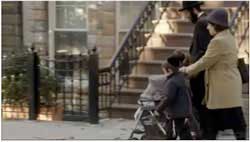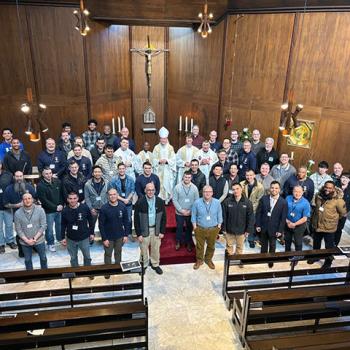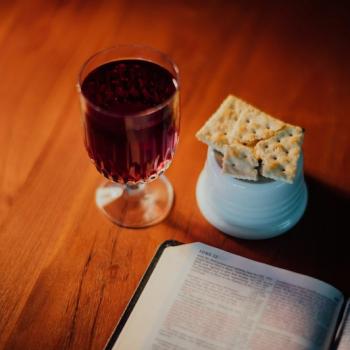This happens two or three times. Then another PA, our original PA, walks up to us, shaking his head. "Something's not right," he announces, finally, after looking each of us up and down. "You. Come here."
He is talking to me.
He takes my coat again, pulls me back down the sidewalk to the other end. There's a young, short woman there who's been doing exactly what we've been doing from the other end, walking down the street pushing a stroller. Three small kids are in tow. "Walk with her," he tells me. "Be a family. Hustle your kids along. You know - help out the wife."
I actually do have a wife. She's small and Hasidic and dark-haired. I have a daughter, too. I peek inside the carriage. Yep. Plastic. This is not my wife. This is not my child.
The good wife orthodox.
But, hey, I am an actor. That's why I got here. Because I can lie so well, I can even fool myself.
Again, someone calls action. We hustle.
One thing I never thought I'd have to do on a film set: babysit.
My new wife and I have four kids -- three real, one plastic. The real kids (the youngest is five, the oldest is eight; improbable, even for a Hasidic family) are pretty clearly not Hasidic. One boy is flicking the other's payos. The girl is trying to reach into the baby carriage without us noticing and turn the baby upside down. "What's your name, sweetie?" asks my ostensible wife. "Charlotte," says the girl, sweet as pop rocks. "Well, Charlotte, sweetie," she says, "please stop messing around with your little baby brother, or else you'll never work in the industry again."
 Her lips curl back in a cruel smile. She manages to be elegant, polite, and unflinchingly brutal. She could completely pass as a Hasidic mother. Well, she could if it weren't for the hair and the hat. She introduces herself as Beatrice, and offers her hand - a telling sign (as if everything else wasn't) that she's only Orthodox for the day.
Her lips curl back in a cruel smile. She manages to be elegant, polite, and unflinchingly brutal. She could completely pass as a Hasidic mother. Well, she could if it weren't for the hair and the hat. She introduces herself as Beatrice, and offers her hand - a telling sign (as if everything else wasn't) that she's only Orthodox for the day.
And now, a note about the clothes: She's wearing her hair short, tucked up under a cloche, which is a '50s-style hat that's become weirdly fashionable in Modern Orthodox communities in recent years, but is next to anathema in most Hasidic circles. All the women are wearing flats (correct) and dark tights (depends which neighborhood you're in, but, okay, potentially correct) and long skirts, which definitely are Hasidic...although there's something unspoken, something intangible about some long skirts that is Hasidic, and something about others that isn't. I can't tell you what it is. Maybe I've been Hasidic so long that I have some sort of Hasid-dar, like when I had a gay roommate and developed really good gaydar? But right now, I am ostensibly surrounded by Hasidim, and it ain't goin' off.
One thing I will say that they got accurate: the kids aren't wearing Hasidic clothes. For some reason, although men are required to wear white shirts and black pants, and women have to have their wrists and nostrils covered, young boys can wear Gap jeans and girls can wear two-inch skirts and spandex everythings. (As a parent, my hypothesis is that kids will ruin clothes as fast as they wear them, so you're better off just getting the cheap stuff.) Similarly, these kids were dressed in their Children's Place best - except for the fake payos and (real) yarmulkes, you couldn't tell they were Jewish. As a matter of fact, the next time that Beatrice tells the kids to be quiet and pay attention, they're discussing what Halloween costumes they're going to wear.
A costuming person runs up to us in a frenzy, stopping the action just as it's about to be called. "Your rings!" she yelps. She empties a variety of small gold bands into her palm. The PA grins at us wickedly. "Wouldn't do for that baby to be born out of sin," he says, gesturing toward our plastic progeny.
Beatrice chooses a ring swiftly. With me, it's harder. "I'll wear one," I offer. "But married Jewish men don't wear rings."
The costuming person doesn't believe me. I tell her, I'm married - do you see a ring on my hand? We go back and forth a bit. Eventually, she shrugs it off and leaves.
"Typical," Beatrice says -- gently, but unmistakably critical. "The women get marked, and the men get let off easy."
"That's not true!" I insist. "There are ways to tell if a man's married, too."
"What are they, then?"
I flounder. The 5 a.m. curtain call is catching up with me. Then I recover: "By this coat," I say, remembering for the first time in a while how I'm dressed. "Only married men wear coats like this. There are also special kinds of hats, and socks" -- well, okay, stockings, but I don't want to get too (ahem) technical -- "and unmarried men don't wear a tallis when they pray..."




